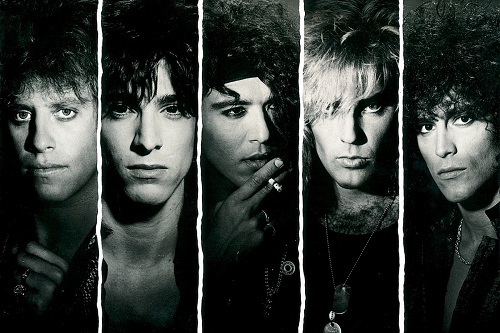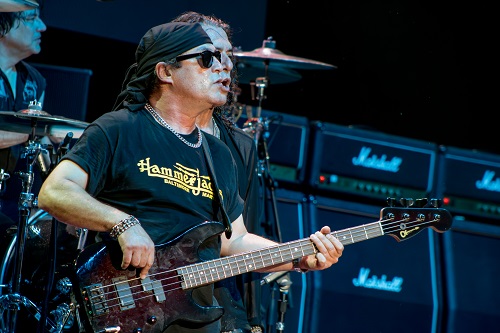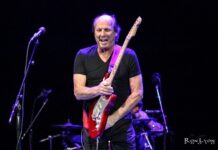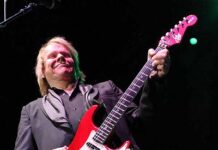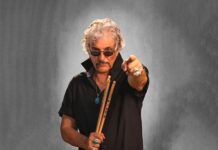By Greg Prato
In Part 1 of our interview with Ratt’s Juan Croucier, the band’s bassist discussed each and every album included on the group’s recent The Atlantic Years: 1984-1991 box set. In this second part, Croucier takes us on a guided tour throughout Ratt’s history.
~
How did you first cross paths with the other members of Ratt?
Back then, there was a little magazine called The Recycler. And it was free. In the back of it, it had ads that musicians would put — along with various other ads — and you’d find “GUITAR PLAYER LOOKING FOR ROCK BAND,” “BAND LOOKING FOR DRUMMER.” So, I connected with Robbin Crosby and we talked a little bit. I invited him over to my apartment, and the moment he showed up…I’m staring straight ahead, and all of a sudden, I’m sort of looking at this guy’s chest! I look up, and there’s this guy the size of a football player — with leather pants on, biker boots. Just dressed to the nines. We spoke, and he played me some songs, and I played him some songs, and we sort of connected that way. Robbin and I decided at that point in time we’d stay in touch and figure out what was going on down the road. There was a lot of networking involved back then. And of course, you’ve got to remember — there was no internet back then or cellphones. Everything was done by just meeting and calling people and so forth. The next thing, this friend of mine at the time, Bobby Blotzer, was going to audition in a band he was going to play in. He had been playing with my brother Tom in a band called Vic Vergat — and they had just finished touring with Nazareth. He wanted to continue playing locally, so, we loaded up his drums into my truck, and I took him to I think it was Culver City — and dropped him off at this audition. A couple of weeks later, he calls me up and says, “Hey, I can’t play with this bass player. Can you come in and work with me on this project?” At that point in time, I was just a working musician — pretty much starving. Y’know, eating Top Ramen. So, I said, “Sure, if it pays a little bit. Let’s do some gigs, have some fun. I can maybe get some groceries.” I learned the tracks that they had, came down and played, and then we started playing around Hollywood.
How would you describe the Sunset Strip in the 80s?
It was amazing. It was a great, great magical time. The scene was just thriving. During the week, there would be all sorts of people at the clubs. You’d pull up to a club and there would be a bunch of people outside and just different bands playing in different venues. You had the Starwood, the Troubadour, the Whisky, the Roxy, the Central, Roxbury, and so forth. There were quite a few places to visit. It was just really energetic. There was a vibe that was really fun and exciting. It was just a great time for music.
Do you agree that there was a clear divide between glam metal and thrash metal in the 80s?
The differences in bands back then…there were significant differences. And everyone was trying to do unique things. There was a band called Sorcery — that never made it — but they literally had a magic show with a rock band playing behind it! So, there were a lot of bands that were trying to find their own niche. Metallica was a great band back then — they were great players, they had a lot of energy. You could tell that they had a unique style. You just mentioned thrash — it was definitely its own unique style. And they had their own unique audience. And I can tell you that even back then, we could tell that the audience was different from the audience that came to see Ratt or another band of our ilk. That’s what I meant by it was a really healthy and thriving scene back then. There were a lot of different bands doing different styles — within a subset. It was pretty entertaining. There was a lot of creativity involved and a lot of effort — believe me. A lot of guys would be stapling flyers up on poles, while the other guy came up and stapled their band over the other band. People were making a concerted effort to get noticed.
Before becoming a permanent member of Ratt, you played with Dokken.
I started with Don early, early on. I think I was about 17 or 18 years old. We had a three-piece band and we were from Redondo Beach. There was a cool club there called the Smokestack — right by the harbor. And eventually, it became the Fleetwood. So, I was in a band called Spike and he was in a band called Airborne. Like I said before, a lot of musicians would network – just be out, checking out who was who, and who was playing with what band, and what band had broken up and things like that. There was also a club next to the Fleetwood called the Sweetwater — that was more of an R&B/jazz place. So, there was a little area there where the music scene was kind of happening — a sort of microcosm away from Hollywood. I saw a lot of bands there, and also ran into Don and got to know him. And before too long, we formed a three-piece — it was him, I, and a drummer named Greg Pecka. We started playing around — we opened up for Quiet Riot, we played with all kinds of bands. We opened up for Van Halen at the Smokestack. It was great – Van Halen really had a great energy. This was back when Van Halen were playing covers. They had “Runnin’ with the Devil,” “Ice Cream Man,” “You Really Got Me”…they also played a song called “Goin’ Down,” and “Man on the Silver Mountain” — stuff like that. So, Don and I just kept the band going. Eventually, what we ended up doing was we went to Germany and we toured in Germany for about a month. Don met a club owner there, and he was willing to promote the band throughout Germany — so, we went and did that. We worked really hard. And then at a later point in time, we elected to recruit George Lynch and Mick Brown, and it went on from there. It was a very difficult decision to choose between Ratt and Dokken. And the reason is I had worked in Dokken for a really long time and was really invested in the band. And we had finally gotten great management — with Peter Mensch and Cliff Burnstein, a company called Q Prime. They manage Metallica these days. Great managers, really smart guys. And we were on our way to having a deal with Elektra Records. I remember the day that I walked into Elektra Records with Cliff Burnstein, and he had the Pyromania artwork under his arm to present it to the record company. There was a lot going on there, and Dokken basically had a record deal, Ratt didn’t. Once we integrated Mick and George…George and Don didn’t get along. It was a unique situation — we had brought Michael Wagener in from Germany to produce the Dokken record. He started working with other bands and making other records for other people, and we were waiting and waiting — and that’s when I began playing with Ratt. It was a really tough decision. Ratt felt right to me. It felt “at home” — even without a record deal. And believe me, a lot of bands had a lot of high hopes. Y’know, most of the guys out there in the clubs were sure they were going to make it. However, reality dictated differently. So, there was a calculated risk for all the right reasons. I wanted to do the right thing and be in the right situation — and Ratt felt really good. So, I went ahead with Ratt.
By and large, how did the songwriting work in Ratt?
I would bring in songs that were completed, or I’d have a track that I thought was real strong. And others would come up with parts and we would work on the music together, and then we’d go from there. It was sort of different, because there were a lot of…I guess the best way to say it is when you’re working with a producer, the producer has a certain vision and certain priorities that they want. So, we just tried to bring out the best in each individual in the studio — and have a group of songs that would work well together. Without getting too into details, we would try to take things that had potential and bring them to fruition. Sometimes it would work, and other times it wouldn’t. We just gave it the best shot with the tools that we had at the time. It was a collaborative effort to a degree.
How did Robbin and Warren work out their guitar parts?
That’s all we did — we rehearsed. The idea was to refine the songs and make them better. Again, there were a lot of moving parts back then — there was a time when Warren left Ratt to join Dokken, and we had to replace Warren (Marq Torien served as his replacement) and then eventually Warren came back. So, we would work a lot to perfect the whole thing. The thing about Ratt that is interesting is we had two guitar players that had uniquely different styles. And those two different styles really sort of constituted the “Ratt signature sound,” if you will. On the one hand, we had Warren DeMartini — who was extremely proficient. A high degree of craftsmanship in his playing. And then you had Robbin Crosby — who was sort of more of a bluesy player. A different feel. So, combining the two created a unique voice of its own color. They worked well together. And in any working relationship, things kind of take their course. But they did work well together — they cooperated a lot. We all had a vision that we were trying to bring into focus with our music. And they did well.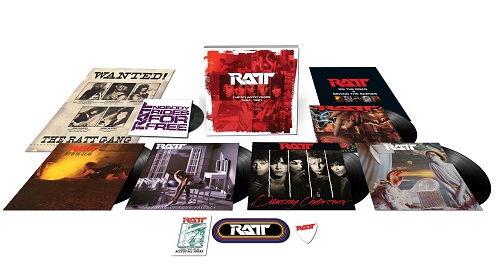
Do you recall when Warren was briefly in Dokken? Was it after the EP?
I believe it was after the EP. It was one of those things where a lot of people were just trying to survive. It was a tough scene. You’d hear about, “Oh, so and so got interest from Warner Brothers.” And you’d be like, “Really?!” Making it/getting a record deal was just this dream that your life was almost depending on it.
How did the band cross paths with Marshall Berle and how was he as a manager? How long was he the manager?
Marshall Berle was around the scene back then. He worked with a lot of different bands — he worked with the Beach Boys early on, and then he was involved with Van Halen. Marshall eventually saw Ratt and became interested. As the band developed and kept working, he offered the group a production deal — where he would get the band into the studio to record, and he had a record company called Time Coast at the time. Back then, things were so different — a band dreamt about going into the studio. It was sort of like getting through the gates of Oz. It became something that was really important to us, because we believed if we could get our music onto some vinyl and get it out to people that that would only help the band in its popularity. He offered us a way to make an EP — we did that, and then his association continued from there. Look, one can always look back and say “Coulda, shoulda, woulda” on a lot of levels. The point is that Ratt became successful. There’s a lot of factors you can always second guess. But at the end of the day, it was a successful situation, and we worked really hard and Marshall was an integral part of that. He was the manager up until I believe 1989 or 1990 — when we decided to go with a gentleman named Allen Kovac, who currently manages Mötley Crüe. Again, a very talented manager. At that point in time, he had been Richard Marx’s manager — and this was when Richard Marx had really exploded onto the scene with a lot of great hit songs. That was the end of Marshall’s tenure with Ratt.
Who designed the band’s look and stage costumes in the ‘80s? Was it a collaboration?
When you don’t have a whole lot of money and you’re just trying to figure out a cool look that works, you don’t have a lot to work with. Obviously, later on when the band had started working and was out there playing, we were able to work with designers and people that had a little more expertise in that type of field. It kind of evolved. We had different times that we’d go for different looks. We wanted to keep it interesting and keep it progressing and evolving. There wasn’t really a specific way — it was a combination of brainstorming and help from others.
Ratt also had an instantly recognizable logo. Do you remember how it came about?
There were a lot of different shapes and sizes and looks to it. First, it was sort of block letters — a little more rectangular. And then over the years, it started getting more streamlined. It was sort of an evolutionary process. I think Stephen worked on the details of it. But you always try to do something that will be easy to remember, simple, and have a visual impact, as well.
How did you come up with your stage moves?
When I was young, I got into martial arts early. And I became really aware of how the body works and how the body moves, and being strong and being limber. Eventually, I incorporated some of that awareness into my performance on stage. I really tried to be very disciplined because I realized that when you’re playing city to city, the one night you’re playing wherever it is – pick a city — it’s the only night they’re going to see you. So, consistency is imperative. I just had a good time and did things that I thought were entertaining and interesting, and I put a lot of effort into it. I took it very, very seriously. It wasn’t something that I took lightly – at all. It was a lot of work. There’s a lot of different ways that you can approach the stage — and I think part of Ratt’s success was that we did try to be entertaining and special in our own way. And not just stand there and play. I did everything I could — in my situation — to create moves for the entire band, and to have a kind of logistical awareness of the stage. Don’t just wander off by your amps and sit there immersed in your solo — remember there’s the audience out there. You’re playing for them. They’re the ones that are here to see you. You have to give them your full attention and make the effort as required.
How would you describe the personalities of all original five Ratt members?
It’s really hard. It’s complicated. I think we all had the same vision…I just think we had five different ways of getting there. We were certainly not at a loss for opinion, and we did the best we could. I think that a combination of working so hard and for so long, and the pressures of performing at a very high level…everyone sort of dealt with it differently. But it would be really difficult for me to sit here and go through all the different personality traits. [Laughs] Because there is a lot to it — there’s a lot there.
When Stephen posed for Playgirl Magazine in 1986, do you feel it helped or hurt the band’s image?
I don’t really think at the time it mattered either way. Robbin Crosby married Laurie Carr — who was also a Playmate. So, there was sort of an indirect association that way. I’m not sure people really cared either way.
Who did you consider Ratt’s main competition in the 80s?
I honestly don’t view it as “competition.” There were a lot of bands that were really good hard rock bands. So, you had the obvious culprits. What we set out to do was be unique and be ourselves, and find our voice — among the many groups that were out there. There were a lot of really talented bands. What a lot of folks don’t realize is there were hundreds and hundreds of bands playing these clubs on a given night. It wasn’t uncommon for us to get together at the Troubadour and watch Metallica play. And this was back when Dave Mustaine was in the band. I can’t really say that we had a band that was a competition — it was really more like we were trying to find our own voice and something that made us stand out from the rest.
What is your favorite Ratt video?
Maybe “You’re in Love” — it’s basically a cool live video. It just kind of caught the vibe of the Invasion of Your Privacy tour. But it was also really fun taping the “Wanted Man” video. We did it while we were on the road — in between gigs. We woke up real early, got ready, mounted the horses, and did the different scenes that were involved. And then immediately thereafter, we took off on the bus to the next show and performed that evening. A lot of them have their own neat things about them – the “Back for More” video was also fun, as well. It’s hard to pick one.
Why do you think there has been a re-appreciation of Ratt’s music and other 80s metal bands over the last few years?
I think quality bands, quality songs, and attention to detail. I believe the 80s were a really special time for music. The 60s brought a certain kind of awareness to music — you had Motown and the hippie era. And a lot of new music that was coming out — flower power. The music in the 70s had certain bands that were really crafting their musicianship and the singer-songwriter thing, and pop — AM radio hits continued to be substantial from the 60s. So, there was a certain vibe in the 70s that was unique to the 70s. And the ‘80s had the same sort of thing — where a new group of bands came out and you had the punk scene, the new wave scene, and the hard rock scene. There were several movements that occurred there. I think that there’s something about those ‘80s bands…you had MTV that had come into existence and you had a lot of new factors that made the music unique and bands respond uniquely to. You definitely have a lot of bands from that era that created a special point in time. So, when you go back and listen to those songs, I think people are pleasantly reminded of that decade and beyond it. I think it was a decade — in my mind — that stood out.
Streaming services such as Spotify have helped introduce Ratt’s music to a newer or younger audience.
Yes, absolutely. That’s the other factor now — the way people listen to music is so different. Remember, the 60s, 70s, and 80s, people had stereos. And putting a record on would be a thing. And looking at the record cover and seeing who played on it and who produced it and where they recorded it. All this stuff was really an interesting thing to immerse yourself in. Now, in this modern age, people consume music much differently. So, things like Spotify and iTunes are fundamental to people digesting new music in unique ways — they can create their own playlists, they can search for things based on…y’know, “I want to hear some ballads.” Remember, back then, you’d buy a record because you’d hear a great song on the radio and then go home and go, “Oh shoot. That’s the best song on the record!” (Laughs) With Spotify and the different streaming services now, you can really pick and choose what songs you like and get through all the stuff you don’t even want to bother with.
What did you think about Ratt’s Behind the Music episode that aired on VH1 in 2006?
When I first saw it…I hadn’t seen it before it was edited. So, what occurred was Robbin Crosby did his interview at first — before the rest of us did. And then unfortunately, he passed. So, by the time it was decided that they would actually go through with doing it — our version of Behind the Music — there was a few years that went by. In fact, Robbin did his interview right around 2000, and he passed in 2002. So, we picked up the Behind the Music again in 2006. When we saw the edited version — the final version we saw basically at the same time everyone else did — it was like as if he was still alive. It was sort of a melancholy feeling of…it was a mixture of a lot of feelings – missing one of my best friends, and yet having him participate. So, it was bittersweet. And I’m glad that he was included — I thought that was great. Behind the Music had a lot surprises I think for everyone. Nobody really knew what the other guy was going to say. Everyone had their own perspective. I enjoyed it – I thought it was a very interesting and fun thing.
How did Ratt come to do the Geico commercial a few years back?
We were on the road and we got a notice that a company was interested in doing a commercial. We got further into it…and it turned out to be Geico. They had an idea and we thought it was great idea. So, we went up to a city called Altadena and we shot it in a day. It was really reminiscent of shooting videos in the 80s — where you had a lot to do in a very short amount of time. The director was excellent — he did a really good job. He said, “We’re going to finish by 6:00.” I chuckled and said, “Yeah. That’s what they always say…at midnight.” But we went through and they had it all mapped out, and we did certain alternate parts for them to be able to pick and choose from. It was really, really enjoyable. It was really neat to see how these things are pieced together. The end result was funny and enjoyable — it was a little “tongue in cheek factor,” obviously. But it was a lot of fun. And believe it or not, at 6:00pm, the video shoot was a wrap. It was like, “Wow. Things have changed.” Really great, a lot of fun, and I’m glad folks liked it.
Looking back on Ratt’s career, is there anything you would have done differently?
There’s a reason why they say, “Hindsight is 20/20, right?” There are just so many variables. When you have a group of five guys, you’ve got the potential for greatness and you also have the potential for a disaster. So, navigating that could be tricky. And of course, individuals are individuals. You have folks who have different priorities and different visions. We did the best that we could. Ratt set out to conquer the world — in our own way — and we got pretty far. Again, looking back on things, sure, there were a lot of things that I wish we could have done differently if we’d known better at the time. But that’s the thing about being in a rock band — there’s a risk factor. And unpredictability.
